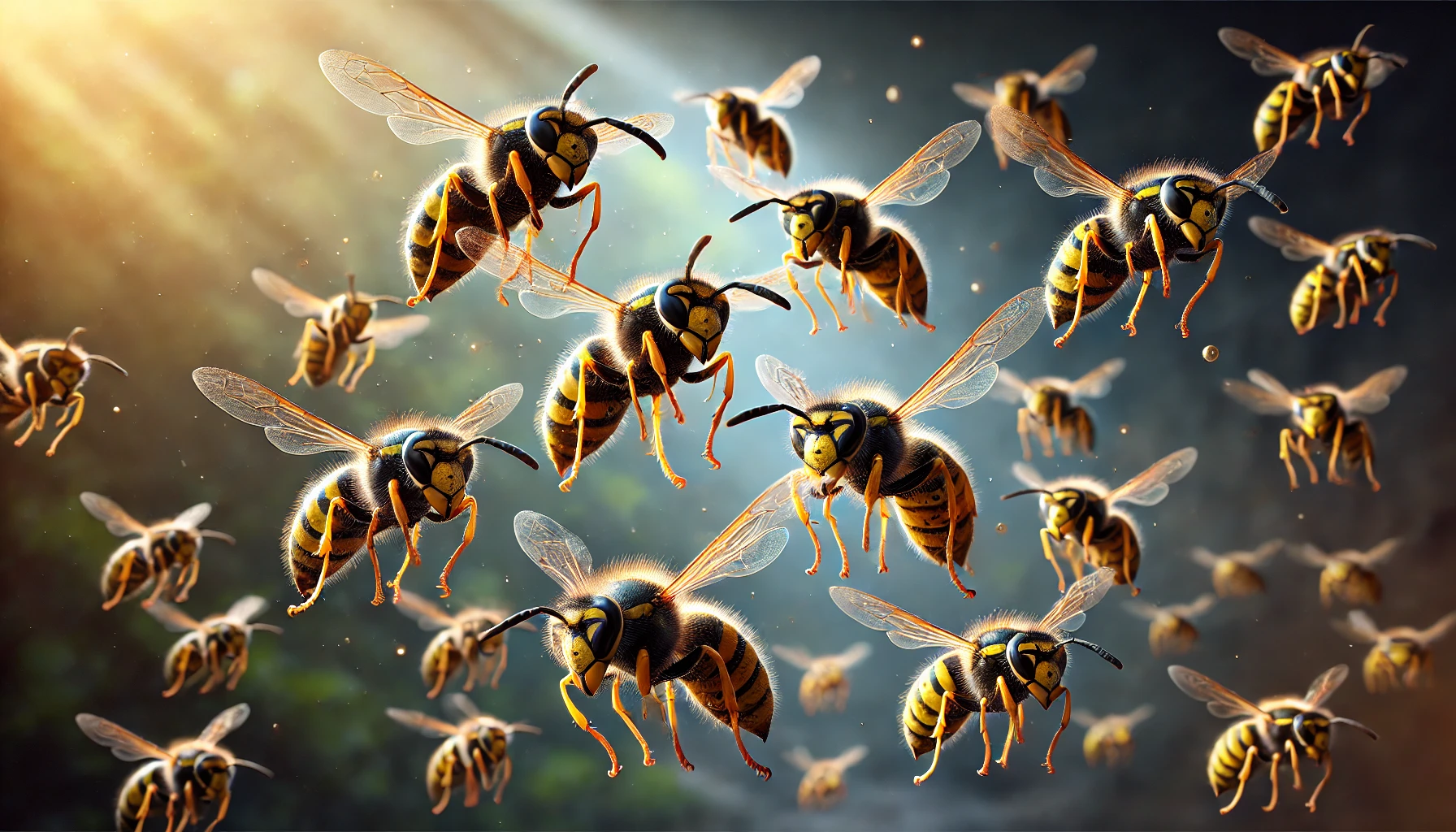Key Takeaways
- Wasps cruise around at 7–10 mph but hit speeds of 20–25 mph when agitated or hunting.
- Their wings and body design let them accelerate quickly, turning them into tiny aerial acrobats.
- Humans can technically outrun wasps, but quick acceleration and agility give wasps a temporary edge.
- Keeping your distance, securing food sources, and carefully managing your yard can prevent unwanted encounters.
- When in doubt, call professional pest control—because you definitely don’t want to become the neighborhood spectacle like Tom.
 Have you ever had that moment where you’re peacefully grilling in the backyard, and suddenly—zoom!—a wasp buzzes past your ear at what feels like Mach speed? You jump, spill your drink, and wonder: “How fast can these little guys actually fly, anyway?” You know what? You’re not alone in that curiosity.
Let’s slow down (because wasps certainly won’t) and talk about wasp flight speeds, their fascinating behaviors, and what you can do when they turn your yard into their personal racetrack.
Have you ever had that moment where you’re peacefully grilling in the backyard, and suddenly—zoom!—a wasp buzzes past your ear at what feels like Mach speed? You jump, spill your drink, and wonder: “How fast can these little guys actually fly, anyway?” You know what? You’re not alone in that curiosity.
Let’s slow down (because wasps certainly won’t) and talk about wasp flight speeds, their fascinating behaviors, and what you can do when they turn your yard into their personal racetrack.
So, Just How Fast Can Wasps Fly?
Alright, picture this: the average human walks about 3 to 4 mph—comfortable, leisurely, nothing crazy. Imagine something flying around your head at double, even triple that pace. Yeah, that’s your typical wasp. Most common wasps, like those pesky yellow jackets or paper wasps lingering around your soda, cruise about 7 to 10 miles per hour. It’s not blindingly fast, sure, but when it’s buzzing inches from your face, it sure feels like warp speed.But here’s the kicker: when threatened or on the hunt, wasps can seriously hit the gas pedal, reaching speeds upto 20 to 25 mph in short bursts. Your casual swat or half-hearted jog might not be enough if you accidentally disturb their home base.


Not getting a solution?
Get your free pest control estimate today!What Makes Wasps Such Speed Demons?
Good question. Let’s talk wings. A wasp isn’t exactly built like your standard aircraft, but it might as well be. Wasps have two pairs—front wings bigger than the back ones—that hook together when flying. And these wings beat insanely fast—hundreds of times per second, creating enough lift for quick acceleration and sharp turns. Imagine a tiny helicopter with ninja-like reflexes; that’s your neighborhood wasp.Their streamlined bodies help, too. Ever notice how thin wasps seem compared to bees? That slender, lightweight shape allows them to dart and weave effortlessly through the air, turning on a dime to chase prey or escape predators. It’s nature’s version of an agile fighter jet.
When Do Wasps Floor It?
You might assume wasps buzz around at full throttle all the time, but they’re surprisingly energy-conscious (who knew?). They usually reserve turbo mode for specific situations:Defending the Nest (A.K.A. Home Turf Advantage)
If you’ve accidentally kicked a hidden nest, you know exactly what this feels like. Wasps release alarm pheromones—think of it as their version of an emergency siren. Within seconds, they’re airborne, aggressively zipping toward the threat (that’s probably you, unfortunately). At this point, they’re miniature missiles with one mission: protect the queen and colony at all costs. Hunting for Prey Wasps are expert hunters, snagging flies, caterpillars, and even spiders mid-flight. To do this, they rely on swift bursts of speed to surprise their prey. Imagine trying to catch a mosquito in mid-air. Yeah, challenging stuff, right? But wasps do it regularly, thanks to their quick reflexes and lightning-fast acceleration. Sunny Skies and Warm Breezes Wasps love warm, sunny days—just like we do. Warm weather revs up their muscles, boosting their flight efficiency. So, if you’ve ever felt like wasps are extra active during those bright summer afternoons, you’re absolutely right. Conversely, chilly weather or rain makes them sluggish (finally, some good news!).
Can You Outrun a Wasp?
Honestly, it’s complicated. Technically speaking, the average adult can run faster than a wasp’s regular cruising speed. Healthy adults can sprint about 12 to 15 mph, surpassing the 7–10 mph of a leisurely flying wasp. But—and it’s a big one—wasps don’t leisurely chase you when angry; they sprint-fly at 20–25 mph speeds. Add to that their near-instant acceleration, and suddenly outrunning a wasp seems less straightforward, right? Here’s the thing: outrunning wasps isn’t impossible, but it’s not easy. If you try to disturb a wasps nest, your finest way is sprinting straight out of their area —usually around 50 to 100 feet. Don’t zig-zag; that only gives them more time to catch up. Get indoors if you can, but don’t lock yourself in a confined space with a buzzing pursuer. It’s not a pleasant scenario, trust me.Keeping Peace (and Distance) from Your Local Wasps
Look, wasps aren’t deliberately hostile malicious. Understanding their flight habits helps you coexist without constant anxiety. Here are some practical and important tips: Locate Their Hangouts (And Give ‘Em Space) Have a routine for checking of nests—under eaves, decks, bushes, and even in the ground. Once you locate them, maintain your distance with them. Wasps are seen as they won’t bug you unless you raid their turf. In other langauage,its called respecting boundaries with a neighbor who’s a bit grumpy. Hide the Good Stuff Wasps are suckers for sweet drinks, fruit, and BBQ leftovers. Try to cover your food, keep your garbage sealed, and clean spills promptly. Less temptation means fewer buzzing visitors interrupting your peaceful summer afternoon. Suit Up (When Necessary)
Do gardening or outdoor work near a known wasp area? Long sleeves, pants, gloves—basically, think beekeeper chic. It might not win fashion awards, but it’ll save you from unnecessary stings.
Call in the Pros
If you’re having a deal with a large nest near common areas—like your porch or children’s play area—don’t risk it. Contact pest control specialists who have the right gear and know-how to relocate or remove the nest safely.
A Quick Storytime Detour (Because Why Not?)
You know what? Speaking from experience here, a wasp sting isn’t fun. A friend of mine—let’s call him Tom—thought he could quickly tease down a small nest from his porch. Big mistake. Within seconds, he went down the street, wasps hot on his trail. He escaped uninjured predominantly (except his pride), but actually, he still flinches whenever something buzzes nearby.
Moral of the story? Respect their speed, respect their space. It’s much easier (and less embarrassing) that way.
If you feel things have gone out of control, it is advised to contact pest control professionals. Our team can provide a customized approach to protect your home effectively.
Suit Up (When Necessary)
Do gardening or outdoor work near a known wasp area? Long sleeves, pants, gloves—basically, think beekeeper chic. It might not win fashion awards, but it’ll save you from unnecessary stings.
Call in the Pros
If you’re having a deal with a large nest near common areas—like your porch or children’s play area—don’t risk it. Contact pest control specialists who have the right gear and know-how to relocate or remove the nest safely.
A Quick Storytime Detour (Because Why Not?)
You know what? Speaking from experience here, a wasp sting isn’t fun. A friend of mine—let’s call him Tom—thought he could quickly tease down a small nest from his porch. Big mistake. Within seconds, he went down the street, wasps hot on his trail. He escaped uninjured predominantly (except his pride), but actually, he still flinches whenever something buzzes nearby.
Moral of the story? Respect their speed, respect their space. It’s much easier (and less embarrassing) that way.
If you feel things have gone out of control, it is advised to contact pest control professionals. Our team can provide a customized approach to protect your home effectively.
Visit our Species, Control, and DIY Guide sections for additional resources on wasps and ways to tackle a wasp infestation.





